上海交通大学:《材料与社会 Materials & Society》课程教学资源(课程资料)Discovery of novel materials and structures

http://smse.sjtu.edu.cn/mintro/index.htm E-mail:ywcai@sjtu.edu.cn Discovery of novel materials and structures
Discovery of novel materials and structures http://smse.sjtu.edu.cn/mintro/index.htm E-mail: ywcai@sjtu.edu.cn
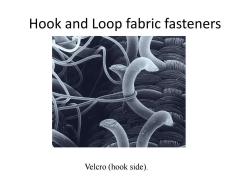
Hook and Loop fabric fasteners Velcro (hook side)
Hook and Loop fabric fasteners Velcro (hook side)
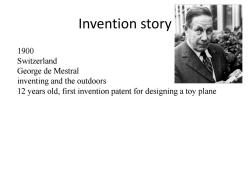
Invention story 1900 Switzerland George de Mestral inventing and the outdoors 12 years old,first invention patent for designing a toy plane
Invention story 1900 Switzerland George de Mestral inventing and the outdoors 12 years old, first invention patent for designing a toy plane
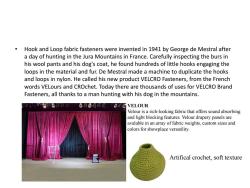
Hook and Loop fabric fasteners were invented in 1941 by George de Mestral after a day of hunting in the Jura Mountains in France.Carefully inspecting the burs in his wool pants and his dog's coat,he found hundreds of little hooks engaging the loops in the material and fur.De Mestral made a machine to duplicate the hooks and loops in nylon.He called his new product VELCRO Fasteners,from the French words VELours and CROchet.Today there are thousands of uses for VELCRO Brand Fasteners,all thanks to a man hunting with his dog in the mountains. 8 VELOUR Velour is a rich-looking fabric that offers sound absorbing and light blocking features.Velour drapery panels are avalable in an array of fabric weights,custom sizes and colors for showplace versatility. Artifical crochet,soft texture
• Hook and Loop fabric fasteners were invented in 1941 by George de Mestral after a day of hunting in the Jura Mountains in France. Carefully inspecting the burs in his wool pants and his dog's coat, he found hundreds of little hooks engaging the loops in the material and fur. De Mestral made a machine to duplicate the hooks and loops in nylon. He called his new product VELCRO Fasteners, from the French words VELours and CROchet. Today there are thousands of uses for VELCRO Brand Fasteners, all thanks to a man hunting with his dog in the mountains. VELOUR Velour is a rich-looking fabric that offers sound absorbing and light blocking features. Velour drapery panels are avalable in an array of fabric weights, custom sizes and colors for showplace versatility. Artifical crochet, soft texture
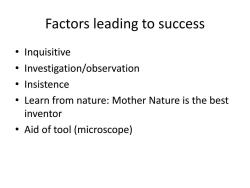
Factors leading to success 。Inquisitive Investigation/observation ●Insistence Learn from nature:Mother Nature is the best inventor Aid of tool (microscope)
Factors leading to success • Inquisitive • Investigation/observation • Insistence • Learn from nature: Mother Nature is the best inventor • Aid of tool (microscope)
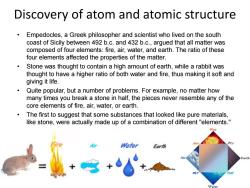
Discovery of atom and atomic structure Empedocles,a Greek philosopher and scientist who lived on the south coast of Sicily between 492 b.c.and 432 b.c.,argued that all matter was composed of four elements:fire,air,water,and earth.The ratio of these four elements affected the properties of the matter. Stone was thought to contain a high amount of earth,while a rabbit was thought to have a higher ratio of both water and fire,thus making it soft and giving it life. Quite popular,but a number of problems.For example,no matter how many times you break a stone in half,the pieces never resemble any of the core elements of fire,air,water,or earth. The first to suggest that some substances that looked like pure materials, like stone,were actually made up of a combination of different "elements." Fire Water Earth Earth
Discovery of atom and atomic structure • Empedocles, a Greek philosopher and scientist who lived on the south coast of Sicily between 492 b.c. and 432 b.c., argued that all matter was composed of four elements: fire, air, water, and earth. The ratio of these four elements affected the properties of the matter. • Stone was thought to contain a high amount of earth, while a rabbit was thought to have a higher ratio of both water and fire, thus making it soft and giving it life. • Quite popular, but a number of problems. For example, no matter how many times you break a stone in half, the pieces never resemble any of the core elements of fire, air, water, or earth. • The first to suggest that some substances that looked like pure materials, like stone, were actually made up of a combination of different "elements
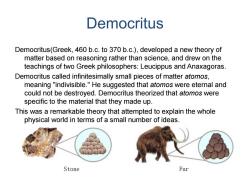
Democritus Democritus(Greek,460 b.c.to 370 b.c.),developed a new theory of matter based on reasoning rather than science,and drew on the teachings of two Greek philosophers:Leucippus and Anaxagoras. Democritus called infinitesimally small pieces of matter atomos, meaning "indivisible."He suggested that atomos were eternal and could not be destroyed.Democritus theorized that atomos were specific to the material that they made up. This was a remarkable theory that attempted to explain the whole physical world in terms of a small number of ideas. Stone Fur
Democritus Democritus(Greek, 460 b.c. to 370 b.c.), developed a new theory of matter based on reasoning rather than science, and drew on the teachings of two Greek philosophers: Leucippus and Anaxagoras. Democritus called infinitesimally small pieces of matter atomos, meaning "indivisible." He suggested that atomos were eternal and could not be destroyed. Democritus theorized that atomos were specific to the material that they made up. This was a remarkable theory that attempted to explain the whole physical world in terms of a small number of ideas. Stone Fur
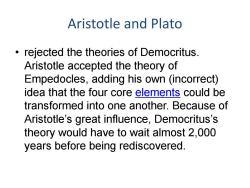
Aristotle and Plato rejected the theories of Democritus. Aristotle accepted the theory of Empedocles,adding his own (incorrect) idea that the four core elements could be transformed into one another.Because of Aristotle's great influence,Democritus's theory would have to wait almost 2,000 years before being rediscovered
Aristotle and Plato • rejected the theories of Democritus. Aristotle accepted the theory of Empedocles, adding his own (incorrect) idea that the four core elements could be transformed into one another. Because of Aristotle’s great influence, Democritus’s theory would have to wait almost 2,000 years before being rediscovered
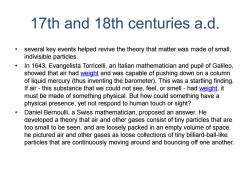
17th and 18th centuries a.d. several key events helped revive the theory that matter was made of small, indivisible particles. In 1643,Evangelista Torricelli,an Italian mathematician and pupil of Galileo, showed that air had weight and was capable of pushing down on a column of liquid mercury(thus inventing the barometer).This was a startling finding. If air-this substance that we could not see,feel,or smell-had weight,it must be made of something physical.But how could something have a physical presence,yet not respond to human touch or sight? Daniel Bernoulli,a Swiss mathematician,proposed an answer.He developed a theory that air and other gases consist of tiny particles that are too small to be seen,and are loosely packed in an empty volume of space. he pictured air and other gases as loose collections of tiny billiard-ball-like particles that are continuously moving around and bouncing off one another
17th and 18th centuries a.d. • several key events helped revive the theory that matter was made of small, indivisible particles. • In 1643, Evangelista Torricelli, an Italian mathematician and pupil of Galileo, showed that air had weight and was capable of pushing down on a column of liquid mercury (thus inventing the barometer). This was a startling finding. If air - this substance that we could not see, feel, or smell - had weight, it must be made of something physical. But how could something have a physical presence, yet not respond to human touch or sight? • Daniel Bernoulli, a Swiss mathematician, proposed an answer. He developed a theory that air and other gases consist of tiny particles that are too small to be seen, and are loosely packed in an empty volume of space. he pictured air and other gases as loose collections of tiny billiard-ball-like particles that are continuously moving around and bouncing off one another
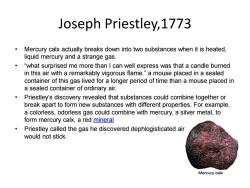
Joseph Priestley,1773 Mercury calx actually breaks down into two substances when it is heated, liquid mercury and a strange gas. "what surprised me more than I can well express was that a candle burned in this air with a remarkably vigorous flame.a mouse placed in a sealed container of this gas lived for a longer period of time than a mouse placed in a sealed container of ordinary air. Priestley's discovery revealed that substances could combine together or break apart to form new substances with different properties.For example, a colorless,odorless gas could combine with mercury,a silver metal,to form mercury calx,a red mineral Priestley called the gas he discovered dephlogisticated air would not stick. Mercury calx
Joseph Priestley,1773 • Mercury calx actually breaks down into two substances when it is heated, liquid mercury and a strange gas. • “what surprised me more than I can well express was that a candle burned in this air with a remarkably vigorous flame.” a mouse placed in a sealed container of this gas lived for a longer period of time than a mouse placed in a sealed container of ordinary air. • Priestley’s discovery revealed that substances could combine together or break apart to form new substances with different properties. For example, a colorless, odorless gas could combine with mercury, a silver metal, to form mercury calx, a red mineral • Priestley called the gas he discovered dephlogisticated air, but this name would not stick
按次数下载不扣除下载券;
注册用户24小时内重复下载只扣除一次;
顺序:VIP每日次数-->可用次数-->下载券;
- 上海交通大学:《材料与社会 Materials & Society》课程教学资源(课程资料)科学、哲学与文明.pdf
- 上海交通大学:《材料与社会 Materials & Society》课程教学资源(课程资料)引言、初识材料.pdf
- 上海交通大学:《材料与社会 Materials & Society》课程教学资源(课程资料)Materials and One’s life.pdf
- 上海交通大学:《材料与社会 Materials & Society》课程教学资料(学生作品)高铁轨道.pptx
- 上海交通大学:《材料与社会 Materials & Society》课程教学资料(学生作品)玻璃与水晶.pptx
- 上海交通大学:《材料与社会 Materials & Society》课程教学资料(学生作品)激光武器 Laser Weapon.ppsx
- 上海交通大学:《材料与社会 Materials & Society》课程教学资料(学生作品)树化玉.ppsx
- 上海交通大学:《材料与社会 Materials & Society》课程教学资料(学生作品)蜜蜂的导航.ppsx
- 上海交通大学:《材料与社会 Materials & Society》课程教学资料(作业论文)金刚石石墨与碳纳米管.pptx
- 上海交通大学:《材料美学》课程教学资源(作业展示)枪械与材料.ppt
- 上海交通大学:《材料美学》课程教学资源(作业展示)材料因“数”而美.ppt
- 上海交通大学:《材料美学》课程教学资源(作业展示)木材之美.ppt
- 上海交通大学:《材料美学》课程教学资源(作业展示)智能服装材料之美.ppt
- 上海交通大学:《材料美学》课程教学资源(作业展示)从邱园谈植物的结构.ppt
- 上海交通大学:《材料美学》课程教学资源(作业展示)课程论文——花岗岩石材在现代城市中的美学应用初探.pdf
- 上海交通大学:《材料美学》课程教学资源(作业展示)材料美学课程论文——元生美学.pdf
- 上海交通大学:《材料美学》课程教学资源(作业展示)《材料美学》课程综述报告——复合材料在军事上的应用.docx
- 上海交通大学:《材料美学》课程教学资源(作业展示)浅品青花韵.doc
- 上海交通大学:《材料美学》课程教学资源(作业展示)视觉美与性能美的完美结合——蝶翅的结构与功能(蝴蝶翅膀).pptx
- 上海交通大学:《材料美学》课程教学资源(作业展示)蝴蝶翅膀美丽的背后——蝶翅的超微结构及其功能研究.pdf
- 上海交通大学:《材料与社会 Materials & Society》课程教学资源(课程资料)Materials and one's life.pdf
- 上海交通大学:《材料与社会 Materials & Society》课程教学资源(课程资料)日常生活中的材料.pdf
- 上海交通大学:《材料与社会 Materials & Society》课程教学资源(课程资料)材料与社会总论(蔡英文).pdf
- 上海交通大学:《材料与社会 Materials & Society》课程教学资源(课程资料)材料性质与结构之间的关系.pdf
- 上海交通大学:《材料与社会 Materials & Society》课程教学资源(课程资料)材料的历史、分类及性质.pdf
- 上海交通大学:《材料与社会 Materials & Society》课程教学资源(课程资料)材料的重要性与核心要素.pdf
- 上海交通大学:《材料与社会 Materials & Society》课程教学资源(课程资料)论太极图的形成及其与古天文观察的关系.pdf
- 上海交通大学:《材料与社会 Materials & Society》课程教学资源(课程资料)超现实主义画作.pptx
- 上海交通大学:《材料美学》课程教学资源(课件讲义)因材而美——建筑材料与形态美学.pdf
- 上海交通大学:《走进纳米科学》课程教学资源(文献资料)开设纳米技术新生研讨课的实践与体会.pdf
- 上海交通大学:《走进纳米科学》课程教学资源(文献资料)纳米生物传感器和纳米机器人在降压药物中的应用.pdf
- 上海交通大学:《走进纳米科学》课程教学资源(文献资料)纳米磁性载体-靶向缓释体系在 肿瘤治疗中的应用创新.pdf
- 上海交通大学:《走进纳米科学》课程教学资源(文献资料)纳米技术在超导信息传输领域的应用.pdf
- 上海交通大学:《走进纳米科学》课程教学资源(专题讲稿)专题1 认识纳米科学(程先华).pdf
- 上海交通大学:《走进纳米科学》课程教学资源(专题讲稿)讲稿.pdf
- 上海交通大学:《走进纳米科学》课程教学资源(专题讲稿)专题2 纳米科学与人类的认知.pdf
- 上海交通大学:《走进纳米科学》课程教学资源(专题讲稿)讲稿.pdf
- 上海交通大学:《走进纳米科学》课程教学资源(专题讲稿)专题3 纳米技术与生活.pdf
- 上海交通大学:《走进纳米科学》课程教学资源(专题讲稿)讲稿 纳米技术与生活.pdf
- 上海交通大学:《走进纳米科学》课程教学资源(文献资料)减轻汽车发动机磨损的两种方法.pdf
